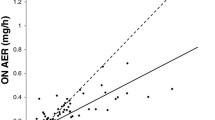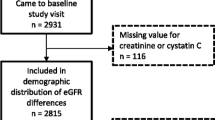Abstract
Objective: To examine the effects of aging on urinary levels of creatinine (CR) and urine specific gravity (SG) among women in a large-scale epidemiology survey. Methods: Data on CR and SG in urine, together with smoking habits and menopausal status, were selected from previously established databases and combined with the results of supplemental sample collection. In total, CR and SG data were available for 11,090 never-smoking women (total group; 29–80 years of age); a subgroup of 1,851 women who lived in Kyoto was also selected from the total group. Data from the two groups were subjected to statistical analyses. In statistical evaluation, SG was converted to factor G, which was defined as (SG−1.000)×1,000. Results: Classification by decade of years of age showed that both CR and SG decreased steadily as a function of advancement in age over 30 years, both in the total group and in the Kyoto subgroup, showing high reproducibility of the observation on a whole-country basis and on a local basis. When the levels at 80 years of age were compared with those at 30 years, there was an approximately 60% and 30% decrease in CR and factor G, respectively. Thus, the effects of aging were more marked on CR than on factor G (and therefore on SG). Menopause appeared to be an influential factor in the reduction of CR and SG, separately from aging itself. Conclusions: Urinary levels of creatinine and, to a lesser extent, urine specific gravity, steadily decreased as a function of ages of over 30 years in women.


Similar content being viewed by others
References
Alessio L, Berlin A, Dell’Orto A, Toffoletto F, Ghezzi I (1985) Reliability of urinary creatinine as a parameter used to adjust values of urinary biological indicators. Int Arch Occup Environ Health 55:99–106
Berlin A, Alessio L, Sesana G, Dell’Orto A, Ghezzi I (1985) Problems concerning the usefulness of adjustment of urinary cadmium for creatinine and specific gravity. Int Arch Occup Environ Health 55:107–111
Boeniger MF, Lowry LK, Rosenberg J (1993) Interpretation of urine results used to assess chemical exposure with emphasis on creatinine adjustments: a review. Am Ind Hyg Assoc J 54:615–627
Buchwald H (1964) The expression of urine analysis results—Observations on the use of a specific gravity correction. Ann Occup Hyg 7:125–136
Bulpitt CJ, Shipley MJ, Broughton PMG, Fletcher AE, Markowe HLJ, Marmot MG, Senmence A (1994) Age differences in biochemical and hematological measures during middle age. Aging Clin Exp Res 6:359–367
Carrieri M, Trevisan A, Bartolucci GB (2001) Adjustment to concentration-dilution of spot urine samples:correlation between specific gravity and creatinine. Int Arch Occup Environ Health 74:63–67
Elkins HB, Pagnotto LD, Smith HL (1974) Concentration adjustment in urinalysis. Am Ind Hyg Assoc J 35:559–565
Ezaki T, Tsukahara T, Moriguchi J, Furuki K, Fukui Y, Ukai H, Okamoto S, Sakurai H, Honda S, Ikeda M (2003) No clear-cut evidence for cadmium-induced tubular dysfunction among over 10,000 women in the Japanese general population; a nationwide large-scale survey. Int Arch Occup Environ Health 76:186–196
Filser D, Bischoff I, Hanses A, Block S, Joest M, Ritz E, Mutschler E (1999) Renal handling of drugs in the healthy elderly. Creatinine clearance underestimates renal function and pharmacokinetics remain virtually unchanged. Int J Clin Pharmacol 55:205–211
Greenberg GN, Levine RJ (1989) Urinary creatinine excretion is not stable: A new method for assessing urinary toxic substance concentrations. J Occup Med 31:832–838
Health and Welfare Statistics Association, Japan (2003) The 19th life table (in Japanese). J Health Welfare Stat 50:68–69
Hosoya T, Toshima R, Icida K, Tabe A, Sakai O (1995) Changes in renal function with aging among Japanese. Intern Med 34:520–527
Hultman E, Soderlund K, Timmons JA, Cederblad G, Greenhaff PL (1996) Muscle creatine loading in men. J Appl Physiol 81:232–237
Ikeda M (1999) Solvents in urine as exposure markers. Toxicol Lett 108:99–106
Inoue O, Kanno E, Kudo S, Kakizaki M, Kataoka M, Kawai T, Ukai H, Ikeda M (1998) High-pressure liquid chromatographic determination of toluene in urine as a marker of occupational exposure to toluene. Int Arch Occup Environ Health 71:302–308
Jackson S (1966) Creatinine in urine as an index of urinary excretion rate. Health Phys 12:843–850
Kawai T, Takeuchi A, Miyama Y, Sakamoto K, Zhang Z-W, Higashikawa K, Ikeda M (2001) Biological monitoring of occupational exposure to 1-bromopropane by means of urinalysis for 1-bromopropane and bromide ion. Biomarkers 6:303–312
Levey AS, Bosch JP, Coggins CH, Greene T, Mitch WE, Schluchter MD, Schwab ST (1996) Effects of diet and antihypertensive therapy on creatinine clearance and serum creatinine concentration in the modification of diet in renal disease study. J Am Soc Nephrol 7:556–566
Levine L, Fahy JP (1945) Evaluation of urinary lead concentrations. I. The significance of the specific gravity. J Ind Hyg Toxicol 27:217–223
Lubran MM (1995) Renal function in the elderly. Ann Clin Lab Sci 25:122–132
Mason HJ, Williams NR, Morgan MG, Stevenson AJ, Armitage S (1998) Influence of biological and analytical variation on urine measurements for monitoring exposure to cadmium. Occup Environ Med 55:132–137
Mayersohn M, Conrad K, Achari R (1983) The influence of a cooked meat meal on creatinine plasma concentration and creatinine clearance. Br J Clin Pharmacol 15:227–230
Ministry of Health, Labor and Welfare, the Government of Japan (2003) National nutritional survey in Japan, 2001 (in Japanese). Dai-ichi Shuppan Press, Tokyo
Nordin BEC, Need AG, Morris HA, Horowitz M, Robertson WG (1991) Evidence for renal calcium leak in postmenopausal women. J Clin Endocrinol Metab 72:401–407
Nordin BEC, Need AG, Morris HA, Chatterton BE, Horowitz M (1993) The nature and significance of the relationship between urinary sodium and urinary calcium in women. J Nutr 123:1615–1622
Nordin BEC, Need AG, Steurer T, Morris HA, Chatterton BE, Horowitz M (1998) Nutrition, osteoporosis, and aging. Am N Y Acad Sci 854:336–351
Nordin BEC, Need AG, Morris HA, Horowitz M (1999) Biochemical variables in pre- and postmenopausal women: reconciling the calcium and estrogen hypotheses. Osteoporos Int 9:351–357
Piers LS, Soares MJ, McCormack LM, O’Dea K (1998) Is there evidence for an age-related reduction in metabolic rate?. J Appl Physiol 85:2196–2204
Rainsford SG, Lloyd Davies TA (1965) Urinary excretion of phenol by men exposed to vapour of benzene; a screening test. Br J Ind Med 22:21–26
Sherwood J (1999) Measurement of specific gravity as a surrogate of urinary flow rate—a singular study. Appl Occup Environ Hyg 14:696–700
Tsukahara T, Ezaki T, Moriguchi J, Furuki K, Fukui Y, Ukai H, Okamoto S, Sakurai H, Ikeda M (2003) No significant effect of iron deficiency on cadmium body burden or kidney dysfunction among women in the general population in Japan. Int Arch Occup Environ Health 76:275–281
World Health Organization (1996a) Biological monitoring of chemical exposure in the workplace, vol 1. World Health Organization, Geneva
World Health Organization (1996b) Biological monitoring of chemical exposure in the workplace, vol 2. World Health Organization, Geneva
Worsfold M, Davie MWJ, Haddaway MJ (1999) Age-related changes in body composition, hydroxyproline, and creatinine excretion in normal women. Calcif Tissue Int 64:40–44
Wyss M, Kaddurah-Daouk R (2000) Creatine and creatinine metabolism. Physiol Rev 80:1107–1213
Acknowledgments
Part of this work was supported by research grants from the Ministry of Health, Labor and Welfare, the Government of Japan, for the fiscal year 2003. The authors are grateful to Miss F. Ohashi for her skillful work in statistical analysis. Cooperation and support of administrations and staff of the following organizations in recruiting study participants are gratefully acknowledged: Hokkaido Industrial Health Management Fund (Sapporo), Miyagi Occupational Hygiene and Medical Association (Sendai), Kanagawa Health Service Association (Yokohama), Niigata Association of Labor Health (Niigata), Chubu Health Research Center (Iida), Kyoto Industrial Health Association (Kyoto), Chugoku Occupational Health Association (Fukuyama), Kochi General Health Service Association (Kochi), Nishinihon Occupational Health Service Center (Kitakyushu), and Okinawa General Health Service Association (Naha), Japan.
Author information
Authors and Affiliations
Corresponding author
Rights and permissions
About this article
Cite this article
Moriguchi, J., Ezaki, T., Tsukahara, T. et al. Decreases in urine specific gravity and urinary creatinine in elderly women. Int Arch Occup Environ Health 78, 438–445 (2005). https://doi.org/10.1007/s00420-004-0597-z
Received:
Accepted:
Published:
Issue Date:
DOI: https://doi.org/10.1007/s00420-004-0597-z




